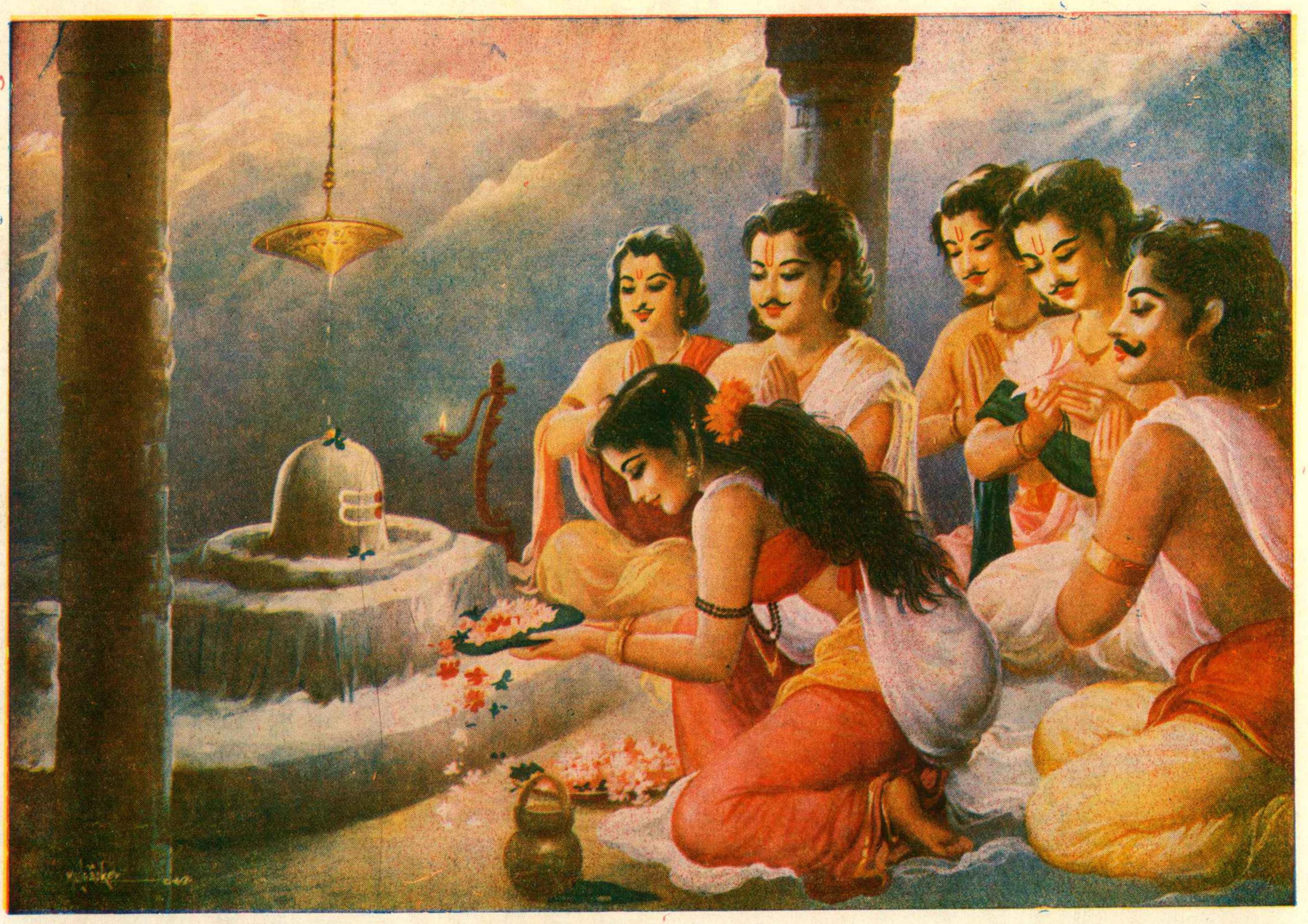|
Krita Yuga
''Satya Yuga'' ( ''Krita Yuga'', IAST: ''Kṛta-yuga''), in Hinduism, is the first and best of the four ''yugas'' (world ages) in a '' Yuga Cycle'', preceded by ''Kali Yuga'' of the previous cycle and followed by ''Treta Yuga''. ''Satya Yuga'' lasts for 1,728,000 years (4,800 divine years). ''Satya Yuga'' is known as the age of truth, when humanity is governed by gods, and every manifestation or work is close to the purest ideal and humanity will allow intrinsic goodness to rule supreme. It is sometimes referred to as the "Golden Age". ''Dharma'' (depicted in the form of a bull) symbolizes morality and stood on all four legs during this period; the legs of ''Dharma'' reduce by one in each ''yuga'' that follows. As per Bhagavata Purana, the four legs of Dharma are , (or ), and . Etymology ''Yuga'' (), in this context, means "an age of the world", where its archaic spelling is ''yug'', with other forms of ''yugam'', , and ''yuge'', derived from ''yuj'' (), believed derive ... [...More Info...] [...Related Items...] OR: [Wikipedia] [Google] [Baidu] |
Puranas
Puranas (Merriam-Webster's Encyclopedia of Literature (1995 Edition), Article on "Puranas", , page 915) are a vast genre of Indian literature that include a wide range of topics, especially legends and other traditional lore. The Puranas are known for the intricate layers of symbolism depicted within their stories. Composed originally in Sanskrit and in Languages of India, other Indian languages,John Cort (1993), "An Overview of the Jaina Puranas" in ''Purana Perennis: Reciprocity and Transformation in Hindu and Jaina Texts,'' (Editor: Wendy Doniger), State University of New York Press, , pages 185-204 several of these texts are named after major Hindu deities such as Vishnu, Shiva, Brahma, and Mahadevi, Devi. The Puranic genre of literat ... [...More Info...] [...Related Items...] OR: [Wikipedia] [Google] [Baidu] |
Vana Parva
The Vana Parva ("Book of the Forest") is the third of the eighteen ''parvas'' (books) of the Indian epic ''Mahabharata''.van Buitenen, J.A.B. (1975) ''The Mahabharata: Book 2: The Book of the Assembly Hall; Book 3: The Book of the Forest''. Chicago, IL: University of Chicago Press Vana Parva traditionally has 21 parts and 324 chapters.Dutt, M.N. (1896) ''The Mahabharata (Volume 3): Vana Parva''. Calcutta: Elysium Press The Textual criticism, critical edition of Vana Parva contains 16 parts and 299 chapters. The parva is a chronicle of the twelve-year journey of the Pandavas in a forest, where they learn life lessons and build character.Bibek Debroy (2011), The Mahābhārata, Volume 3, , Penguin Books Vana Parva contains discourses on virtues and ethics; myths of Arjuna, Yudhishthara, and Bhima; and the tales of "Nahusha the Snake and Yudhishthira" and "Ushinara and the Hawk". It also includes the love stories of "Nala and Damayanti" and "Savitri and Satyavan". Structure and chapt ... [...More Info...] [...Related Items...] OR: [Wikipedia] [Google] [Baidu] |
Epic Poetry
In poetry, an epic is a lengthy narrative poem typically about the extraordinary deeds of extraordinary characters who, in dealings with gods or other superhuman forces, gave shape to the mortal universe for their descendants. With regard to oral tradition, epic poems consist of formal speech and are usually learnt word for word, and are contrasted with narratives that consist of everyday speech where the performer has the license to recontextualize the story to a particular audience, often to a younger generation. Influential epics that have shaped Western literature and culture include Homer's ''Iliad'' and '' Odyssey''; Virgil's '' Aeneid''; and the anonymous '' Beowulf'' and '' Epic of Gilgamesh''. The genre has inspired the adjective '' epic'' as well as derivative works in other mediums (such as epic films) that evoke or emulate the characteristics of epics. Etymology The English word ''epic'' comes from Latin , which itself comes from the Ancient Greek adject ... [...More Info...] [...Related Items...] OR: [Wikipedia] [Google] [Baidu] |
University Of Calcutta
The University of Calcutta, informally known as Calcutta University (), is a Public university, public State university (India), state university located in Kolkata, Calcutta (Kolkata), West Bengal, India. It has 151 affiliated undergraduate colleges and 16 institutes in Kolkata and nearby areas. It was established on 24 January 1857 and is the oldest multidisciplinary university of Indian Subcontinent and Southeast Asian Region. Today, the university's jurisdiction is limited to a few districts of West Bengal, but at the time of its establishment it had a catchment area ranging from Kabul to Myanmar. It is accredited as an "A" grade university by the National Assessment and Accreditation Council (NAAC). The university has a total of fourteen campuses spread over the city of Kolkata and its suburbs. As of 2020, 151 colleges and 21 institutes and centres are affiliated with CU. The university was fourth in the Indian University Ranking 2021 list, released by the National Institu ... [...More Info...] [...Related Items...] OR: [Wikipedia] [Google] [Baidu] |
Oxford University Press
Oxford University Press (OUP) is the publishing house of the University of Oxford. It is the largest university press in the world. Its first book was printed in Oxford in 1478, with the Press officially granted the legal right to print books by decree in 1586. It is the second-oldest university press after Cambridge University Press, which was founded in 1534. It is a department of the University of Oxford. It is governed by a group of 15 academics, the Delegates of the Press, appointed by the Vice Chancellor, vice-chancellor of the University of Oxford. The Delegates of the Press are led by the Secretary to the Delegates, who serves as OUP's chief executive and as its major representative on other university bodies. Oxford University Press has had a similar governance structure since the 17th century. The press is located on Walton Street, Oxford, Walton Street, Oxford, opposite Somerville College, Oxford, Somerville College, in the inner suburb of Jericho, Oxford, Jericho. ... [...More Info...] [...Related Items...] OR: [Wikipedia] [Google] [Baidu] |
Sacred Books Of The East
The ''Sacred Books of the East'' is a monumental 50-volume set of English translations of Asian religious texts, edited by Max Müller and published by the Oxford University Press between 1879 and 1910. It incorporates the essential sacred texts of Hinduism, Buddhism, Taoism, Confucianism, Zoroastrianism, Jainism, and Islam. All of the books are in the public domain in the United States, and most or all are in the public domain in many other countries. Electronic versions of all 50 volumes are widely available online. References External links {{wikisource, Sacred Books of the East, ''Sacred Books of the East''''Sacred Books of the East'' on archive.org (html) [...More Info...] [...Related Items...] OR: [Wikipedia] [Google] [Baidu] |
Shanti Parva
The Shanti Parva (; IAST: ''Śānti parva)'' ("Book of Peace") is the twelfth of the eighteen ''parvas'' (books) of the Indian epic ''Mahabharata''. It traditionally has three parts and 365 chapters.Ganguli, K.M. (1883–1896)Shanti Parva in ''The Mahabharata of Krishna-Dwaipayana Vyasa'' (12 Volumes). Calcutta.Dutt, M. N. (1903). ''The Mahabharata (Volume 12): Shanti Parva''. Calcutta: Elysium Press The critical edition has three parts and 353 chapters. It is the longest book among the eighteen books of the epic. The book is set after the war is over— the two sides have accepted peace and Yudhishthira starts his rule of the Pandava kingdom. The Shanti parva recites the duties of the ruler, ''dharma'' and good governance, as counseled by the dying Bhishma and various ''Rishis''. The parva includes many fables such as that of "the fowler and pigeons". The book also provides what some have described as a "theory of varna" as well as a comparative discussion between a rule of truth ... [...More Info...] [...Related Items...] OR: [Wikipedia] [Google] [Baidu] |
Springer Publishing
Springer Publishing Company is an American publishing company of academic journals and books, focusing on the fields of nursing, gerontology, psychology, social work, counseling, public health, and rehabilitation (neuropsychology). It was established in 1951 by Bernhard Springer, a great-grandson of Julius Springer, and is based in Midtown Manhattan, New York City. History Springer Publishing Company was founded in 1950 by Bernhard Springer, the Berlin-born great-grandson of Julius Springer, who founded Springer Science+Business Media, Springer-Verlag (now Springer Science+Business Media). Springer Publishing's first landmark publications included ''Livestock Health Encyclopedia'' by R. Seiden and the 1952 ''Handbook of Cardiology for Nurses''. The company's books soon branched into other fields, including medicine and psychology. Nursing publications grew rapidly in number, as Modell's ''Drugs in Current Use'', a small annual paperback, sold over 150,000 copies over several edi ... [...More Info...] [...Related Items...] OR: [Wikipedia] [Google] [Baidu] |
Merriam-Webster
Merriam-Webster, Incorporated is an list of companies of the United States by state, American company that publishes reference work, reference books and is mostly known for Webster's Dictionary, its dictionaries. It is the oldest dictionary publisher in the United States. In 1831, George Merriam, George and Charles Merriam founded the company as G & C Merriam Co. in Springfield, Massachusetts. In 1843, after Noah Webster died, the company bought the rights to ''Webster's Dictionary#Noah Webster's American Dictionary of the English Language, An American Dictionary of the English Language'' from Webster's estate. All Merriam-Webster dictionaries trace their lineage to this source. In 1964, Encyclopædia Britannica, Inc., acquired Merriam-Webster, Inc., as a subsidiary. The company adopted its current name, Merriam-Webster, Incorporated, in 1982. History 19th century In 1806, Webster published his first dictionary, s:A Compendious Dictionary of the English Language, ''A Compen ... [...More Info...] [...Related Items...] OR: [Wikipedia] [Google] [Baidu] |
Inner Traditions
Interior may refer to: Arts and media * ''Interior'' (Degas) (also known as ''The Rape''), painting by Edgar Degas * ''Interior'' (play), 1895 play by Belgian playwright Maurice Maeterlinck * ''The Interior'' (novel), by Lisa See * Interior design, the trade of designing an architectural interior * ''The Interior'' (Presbyterian periodical), an American Presbyterian periodical * Interior architecture, process of designing building interiors or renovating existing home interiors Places * Interior, South Dakota * Interior, Washington * Interior Township, Michigan * British Columbia Interior, commonly known as "The Interior" Government agencies * Interior ministry, sometimes called the ministry of home affairs * United States Department of the Interior Other uses * Interior (topology), mathematical concept that includes, for example, the inside of a shape * Interior FC, a football team in Gambia See also * * * List of geographic interiors * Interiors (other) * ... [...More Info...] [...Related Items...] OR: [Wikipedia] [Google] [Baidu] |
Tropical Year
A tropical year or solar year (or tropical period) is the time that the Sun takes to return to the same position in the sky – as viewed from the Earth or another celestial body of the Solar System – thus completing a full cycle of astronomical seasons. For example, it is the time from vernal equinox to the next vernal equinox, or from summer solstice to the next summer solstice. It is the type of year used by tropical solar calendars. The tropical year is one type of astronomical year and particular orbital period. Another type is the sidereal year (or sidereal orbital period), which is the time it takes Earth to complete one full orbit around the Sun as measured with respect to the fixed stars, resulting in a duration of 20 minutes longer than the tropical year, because of the precession of the equinoxes. Since antiquity, astronomers have progressively refined the definition of the tropical year. The entry for "year, tropical" in the '' Astronomical Almanac Onlin ... [...More Info...] [...Related Items...] OR: [Wikipedia] [Google] [Baidu] |




